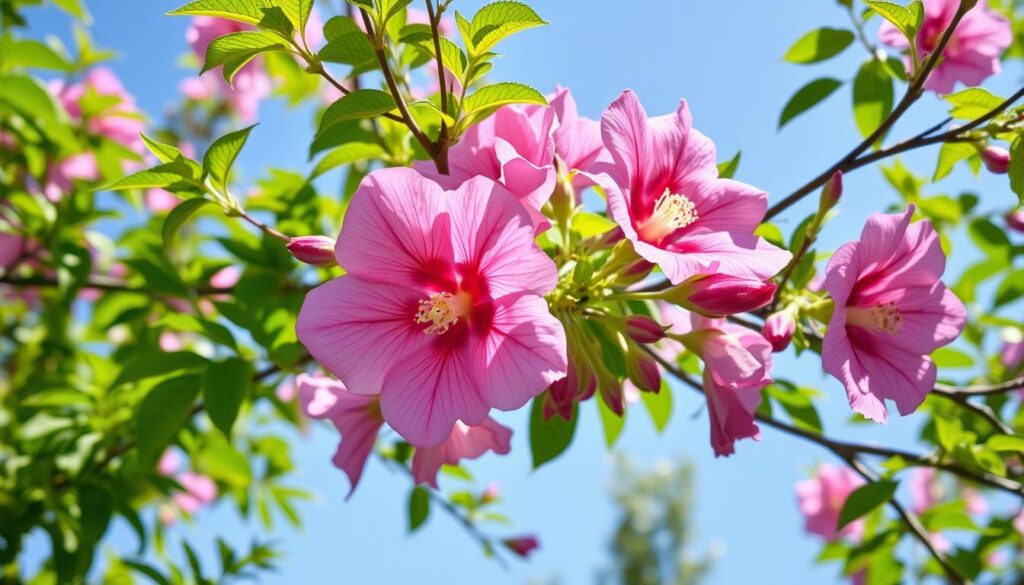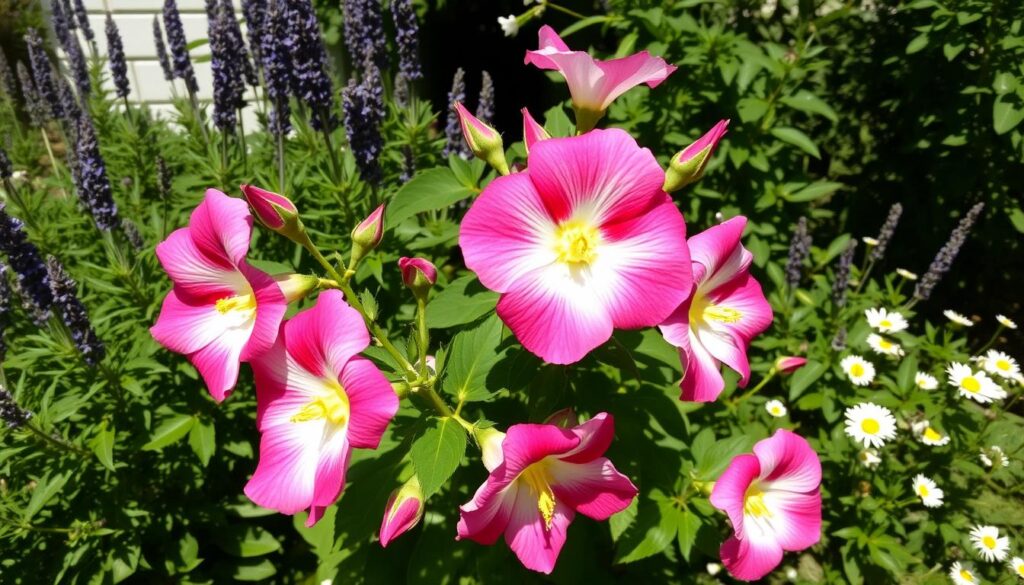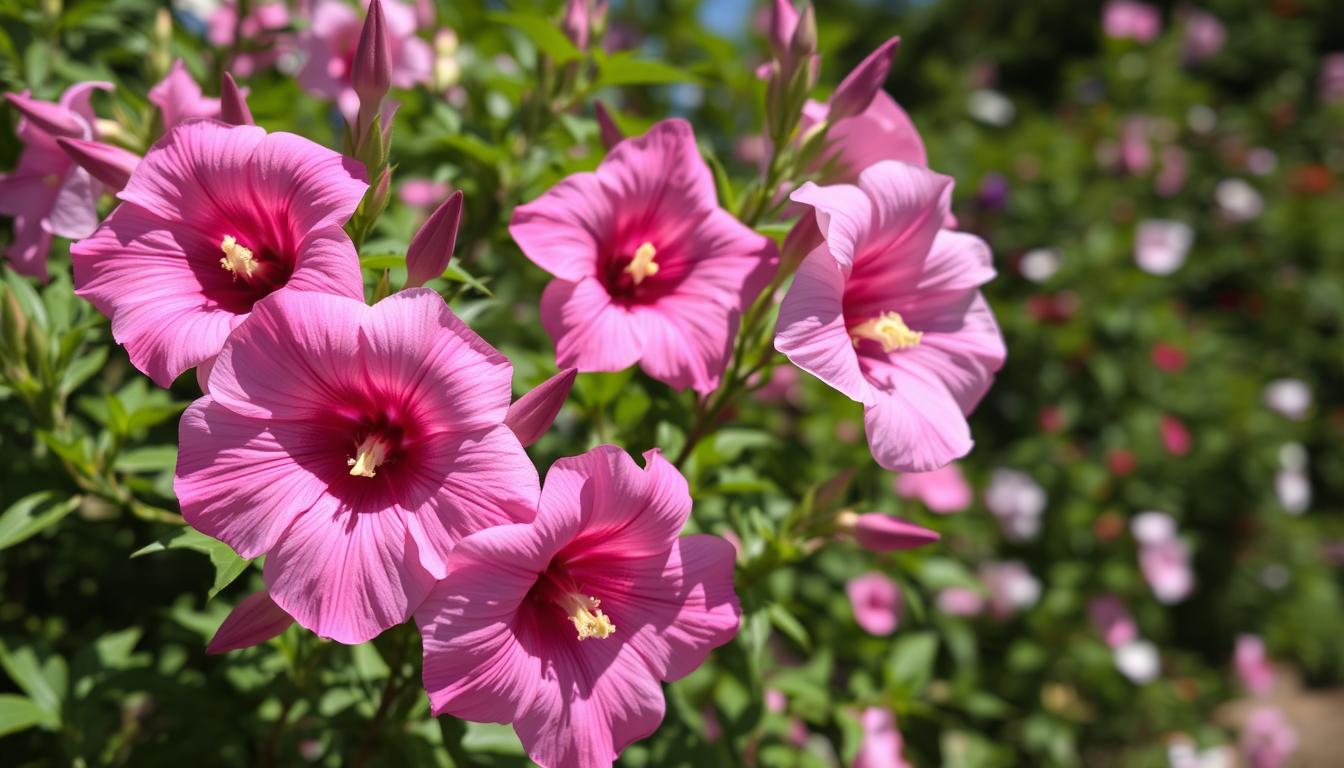As summer arrives, gardens across the nation come alive with the Rose of Sharon in full bloom. This flowering shrub is a favorite among gardeners. It’s easy to see why.
Its vibrant flowers and long blooming period make it a summer highlight. The Rose of Sharon can turn any landscape into a beautiful haven.
Table of Contents
Understanding the Rose of Sharon: A Versatile Flowering Shrub
The rose of sharon is a favorite in gardens across the United States. It’s part of the hibiscus family and brings vibrant colors and lush foliage. With many varieties and stunning blooms, it’s a standout in ornamental plants.
Different Varieties and Colors
The rose of sharon comes in a wide range of colors. You can find everything from soft pastels to bold, eye-catching shades. There are classic whites, pinks, purples, and even reds, blues, and bicolored petals. This variety makes it easy to find the perfect color for your garden.
Botanical Classification and Origins
The rose of sharon is scientifically known as Hibiscus syriacus. It’s a deciduous shrub from eastern Asia, especially China and Korea. It’s related to tropical hibiscus, sharing its big, showy flowers and green leaves. Many cultivars and hybrids have been created, adding to its diversity.
Growth Characteristics
The rose of sharon is a hardy and adaptable shrub. It grows 8 to 12 feet tall and wide, making a full silhouette. It blooms all summer with large, hibiscus-like flowers, adding color to your garden.
Best Growing Conditions for Rose of Sharon Success
Rose of sharon trees and bushes need the right growing conditions to bloom well. They love lots of sunlight, at least 6 hours a day. They grow well in zones 5 through 9, making them adaptable to many places.
Soil is key for these plants. They do best in well-drained, moist, and slightly acidic to neutral soil. A pH of 6.0 to 7.5 is ideal. They can handle different soil types as long as it drains well. Adding compost or organic matter helps them grow strong and bloom more.
“Rose of sharon trees and bushes are incredibly resilient, able to thrive in a range of growing conditions, making them a popular choice for landscaping and home gardens.”
Rose of sharon prefer moderate temperatures. They don’t like extreme heat or cold. In cold areas, mulch around the base helps protect the roots in winter.
With the right conditions, your rose of sharon will bloom beautifully all summer. Make sure they get enough sunlight, the right soil, and moderate temperatures. These plants will add beauty to your garden.
When and Where to Plant Your Rose of Sharon
Ready to add the rose of sharon flower to your garden? Knowing when and where to plant is key. This rose of sharon bush grows well in many places, making it a favorite among gardeners.
Ideal Planting Season
Spring or early fall is the best time to plant your rose of sharon shrub. These seasons help the plant grow strong roots. This way, it’s ready for the next growing season.
Planting in spring lets the rose of sharon adjust before summer heat. Fall planting gives it a start before winter.
Choosing the Perfect Location
Finding the right spot for your rose of sharon flower is important. It likes full sun to partial shade and well-drained soil. Stay away from wet or shady areas, as they can harm its growth.
Spacing Requirements
- Plant rose of sharon shrubs 6 to 8 feet apart for enough room to grow.
- For a rose of sharon hedge, space plants 3 to 5 feet apart for a dense look.
- Think about your rose of sharon variety’s size when deciding spacing.
Choosing the right planting time and spot helps your rose of sharon flower thrive. It will give you a beautiful summer display for years.
Soil Preparation and Planting Guide
Getting your rose of sharon plants, trees and shrubs, or rose of sharon trees ready for planting is key. This guide will help your rose of sharon grow well in its new spot.
Choose a spot that gets full sun to partial shade. Rose of sharon likes slightly acidic, rich soil. If your soil is too heavy or sandy, add compost or aged manure. This will help with drainage and nutrients.
- Dig a hole that’s two to three times wider than the root ball, but not deeper.
- Remove the plant from its container carefully, avoiding root damage.
- Put the plant in the hole, making sure the root ball is level with the soil.
- Fill the hole with the original soil, packing it gently to remove air pockets.
- Water the plant well after planting to settle the soil and keep it moist.
After planting, add a 2-3 inch layer of mulch around the plant. Keep it a few inches from the stem. This helps keep moisture in and weeds out. With proper soil and planting, your rose of sharon plants, trees and shrubs, or rose of sharon trees will bloom beautifully for years.
Essential Care and Maintenance Tips
To grow beautiful rose of sharon flowers and bushes, you need to care for them well. Follow these simple tips to make sure your rose of sharon blooms beautifully every year.
Watering Schedule
Rose of sharon bushes need regular water to stay healthy. Water them deeply, about 1 inch per week. Make sure the soil dries out a bit before watering again.
Change your watering based on the weather. Water more during hot, dry times. Water less when it’s cooler and rainy.
Fertilization Requirements
Feed your rose of sharon with a balanced, slow-release fertilizer in early spring. This helps them grow strong and bloom well. Follow the instructions on the fertilizer package, and don’t get it on the stems.
Also, give them extra food during the growing season. This will help them even more.
Pruning Techniques
- Prune your rose of sharon in late winter or early spring before new growth appears.
- Remove any dead, damaged, or crossed branches to maintain a clean, well-shaped plant.
- Selectively thin out interior branches to improve air circulation and sunlight penetration.
- Deadhead spent flowers to encourage continuous blooming throughout the summer.
By following these care and maintenance tips, your rose of sharon bushes will stay healthy and full of beautiful blooms all season.
Managing Common Pests and Diseases
Keeping your rose of sharon tree or shrub healthy is key to enjoying its summer blooms. These plants can face many pests and diseases. Knowing the common problems and acting early can help your rose of sharon hibiscus stay healthy.
The Japanese beetle is a big problem for rose of sharon. These beetles can eat a lot of leaves, weakening the plant. To fight Japanese beetles, try hand-picking them or use neem oil, a natural bug killer.
- Aphids are another pest that might bother your rose of sharon. These tiny bugs suck sap, slowing growth and causing weird leaves. Check your plant often and use insecticidal soap or water to control aphids.
- Leaf spot diseases, like Cercospora leaf spot, can make your rose of sharon’s leaves look bad. Make sure air moves well around the plant, remove bad leaves, and use a fungicide if needed.
By watching your plant closely and fixing problems fast, you can keep your rose of sharon healthy. This way, it will keep giving you beautiful summer blooms. Always check your plant and act quickly to keep it strong.

“Healthy plants are the foundation for a beautiful and thriving rose of sharon.”
Propagation Methods for Rose of Sharon
If you love the vibrant blooms of rose of sharon plants or bushes, you might want to grow your own. This flowering shrub can be grown from seeds, cuttings, or division. Let’s look at these methods to help you grow more rose of sharon.
Growing from Seeds
Starting rose of sharon from seeds is easy. Collect seed pods in the fall and store them in a cool, dry place. In early spring, sow the seeds indoors and keep them moist until they germinate, which takes 2-4 weeks.
Once the seedlings have true leaves, move them into individual containers. Then, gradually get them used to outdoor conditions before planting in the garden.
Propagating from Cuttings
For a quicker method, take softwood or semi-hardwood cuttings from a bush. Cut 4-6 inch pieces from the current season’s growth. Remove lower leaves and dip the ends in rooting hormone before planting in a potting mix.
Keep the cuttings moist and in a warm, shaded spot until roots develop, which takes 4-6 weeks.
Division Techniques
Division is a simple way to create new plants from mature rose of sharon. In early spring or fall, dig up the plant and divide the root system. Make sure each section has roots and stems.
Replant the divisions in well-prepared holes and water them well to help them establish.
Choose your propagation method and be patient. Give your young plants the care they need. With time and attention, you’ll enjoy the beauty of this summer-blooming shrub for years.
Companion Plants and Landscape Design Ideas
The rose of sharon flower is perfect for any garden. It can mix well with many plants, making your garden look amazing. Whether you want a cozy cottage look or something more elegant, the rose of sharon can be the star of your garden.
Pairing the rose of sharon with other summer flowers is a great idea. Try it with crepe myrtles for more color or hydrangeas for a big, lush look. For a natural feel, group it with native perennials like coneflowers and black-eyed susans.
For a cottage garden vibe, add the rose of sharon with lavender, rosemary, and fragrant herbs. It also looks great as a centerpiece in a more formal garden, surrounded by boxwoods or evergreen shrubs.

The rose of sharon is a great choice for any garden. It adds beauty and interest. With the right plants and design, your garden will be a hit all summer.
Conclusion
The Rose of Sharon (Hibiscus syriacus) is a standout in gardens with its stunning summer blooms. It’s versatile, vibrant, and resilient, fitting many landscape styles. Choose from classic white to bold purple, pink, or red to make it a garden highlight.
This shrub has traveled from East Asia to the United States, thriving in different climates. With the right care, as outlined in this article, your Rose of Sharon will bloom season after season. It’s a rewarding addition to any garden.
When adding the Rose of Sharon to your garden, think about pairing it with plants that complement its beauty. Try different layouts to showcase its versatility. Whether as a solo feature, a hedge, or an accent, it will bring joy and beauty to your outdoor space.

